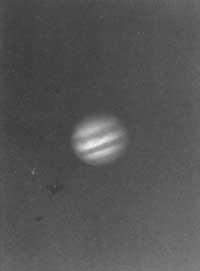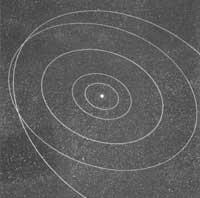Quiet, do not fall on us
If one night we stay looking at the sky, among other things we can see stars, constellations formed by them, planets, satellites and shooting stars. Looking at them and understanding some parameters, we will be able to understand the nature and magnitude of our universe.
Today we will also talk about the planets and their observation.
Planets: Sky Walkers

The relative position between stars does not vary. The ancient human beings realized the existence of luminous points that moved between the stars and were called planets. The meaning of this word is itinerant or “nomadic.” This word describes well the impression of these stars on observers. Planets move in the sky, sometimes in a constellation and sometimes in another constellation.
From time immemorial they realized that the planets never leave the 12 constellations of the zodiac, that is, their movement seems to occur through these constellations. The planets do not move away from the ecliptic. The Ecliptic is the imaginary line that draws the sun when crossing the sky (the reader must remember that the sun does not cross the sky but the earth). Therefore, we now know in what approximate place to look for the planets in the sky.
Easy observation of planets
How to differentiate from stars
It is very easy. Stars blink and planets do not. Stars are very small points, where their luminosity, due to atmospheric turbulence, is cut between 10 and 20 times per second. That is why his light seems to vibrate. The stars show us their light directly, like the sun. On the contrary, the planets are small discs that reflect the sunlight, and as their surface is quite close, when we see their light does not flash.
All the planets, when we look with a telescope, present us with a disc. This is because millions of times are closer to us than the stars. On the other hand, as we have said before, the stars always show us the same position among themselves. On the contrary, the planets seem to cross the sky faster than others. It must be made clear that in a single day we will not realize it. We have to observe them for a long time to realize the movement of our planets.
How to distinguish each planet

We can see 5 planets in sight, that is, without any instruments: Artizar, Jupiter, Martitz, Mercury, and Saturn. Artizar and Jupiter are very bright. The first is brighter than the second, known as the “shepherd star.” We can see it a few months in a row in the morning, before sunrise or in the afternoon after sunset. Artizar will never be seen at midnight because it is quite close to the sun. It is the brightest of the planets and we can say it gives shade.
Jupiter is not as bright as Artizar, but its brightness is greater than that of the prettiest star. Many times we see it at midnight because its orbit around the sun surrounds the earth. Jupiter remains one year in each zodiac constellation, circling the sky for 12 years. If we look with a prismatic or telescope, next to it we can see small points: they are their satellites. It has 12 and only 4 of them are auditory.
Maritz is immediately distinguished by its orange colour. We can be confused with the stars Antares (banana) or Aldebarán, which are next to the ecliptic. But considering what we have said before (how to differentiate stars from planets) we cannot have problems. Its brightness is very variable, sometimes it can be as bright as Jupiter and within a few months we will discover that its brightness has come down a lot.
Saturn has a more stable glow (orange) than the previous planets and once located in a constellation of the zodiac it will be easy to find it for several years, since its displacement is very slow. It lasts two and a half years in each zodiac constellation. So in 30 years he turns to heaven.
The discovery of Mercury will be more difficult as it is very close to the sun. Therefore, near the horizon, we must strive in the luminous skies, looking a little more to the right than the place where the sun rises or a little more to the left than the place where the sun sets. Each time it is visible it can only be distinguished between 4 and 5 days, since then it approaches the sun.
When can we see the planets?


If we want to locate and analyze the planets, it is convenient, at least in the first observations, to follow the instructions that appear monthly in several journals. Almost all these publications have a section in which they explain something like this: “Where can you look for the planets?” With this we will be able to discover the planets in the sky.
I will explain when we can see each planet in 1989 in the following lines:
- MERCURY: The
last week of April and the first days of May an hour after sunset in the northwest.
Last week of June, northeast shortly before sunrise. In mid-October, to the east, an hour before the sun rises again. - ARTIZAR:
At the end of July it will be visible to the east. At dusk and until Christmas we can see it every evening. The brightest time will be in November. It is the brightest point we can see at dusk. It is worth wasting some time with him. - MARTITZ: Throughout winter
and spring will be visible to the east. It will not be very bright and will cross the constellations of Taurus and Gemini until it can not be seen in summer. - JUPITER: We
can see it to the east in the constellation of Taurus (like Martitz), the most luminous point until the month of May. After July it becomes visible again (Gemini). First we will see it at dawn, but then it will leave before (2 hours a month), with the possibility of seeing it all night during Christmas. - SATURN:
From February to December we can see it in the constellation of Sagitarius. In winter in the southwest we will see it a few hours before sunrise. After midnight in spring, throughout the summer night and after sunset in the southeast in autumn.
A very interesting phenomenon is the approximation between planets or some stars. This phenomenon is called conjunction. Bear in mind that this is a relative approach, among them there are thousands or millions of km.
The conjunctions that will occur this year are:
- 12 May: Martitz and Jupiter.
- 3 July: Jupiter and Mercury.
- 17 October: Venus and the star Antares.
- 15 November: Artizar and Saturn.
- 30 December: The star Martitz and Antares.
These dates correspond to the greatest approximation. Considering that the motion of the planets is slow, a week before the day of conjunction for an observer, the planets will have the same position.
Two or three observation boards

At least in the first few days it is interesting to work with who knows, especially because you learn it before.
Leave the city. For example, you can go to the mountain. The tip of Aizkorri can be the ideal place, since there is a shelter to sleep or it is not a bad plan to sleep counting fleeting stars without shelter.
If you have binoculars, taking them with you will help. The most suitable are those with an amplification of 7x50.
Observations are usually more pleasant than in winter, both because of the temperature and the higher frequency of appearance of clean skies.
It may also be appropriate to bring a friend. If the mists enter it cannot be observed and time must be spent on something. Or it may be too cold...
I am sure that now you are going to look at the sky a little more than before, but do not stay calm, because by looking too much do not fall on us...!
Dimension of planets The dimension of the planets is not easy. For this we will make an imaginary comparison. In our model the planets will be aligned, but if we develop lines that indicate their movements would cover an area of 107 hectares. In this model we will reduce the Solar System by a billion. Our model is:
Once this is seen, it must be said that our Solar System is nothing more than a point in the Universe. In our model, for example, the distances between stars would be km and thousands of km. So when we look at the sky, our eyes can see what's happening several million miles away. Is it not surprising? |





